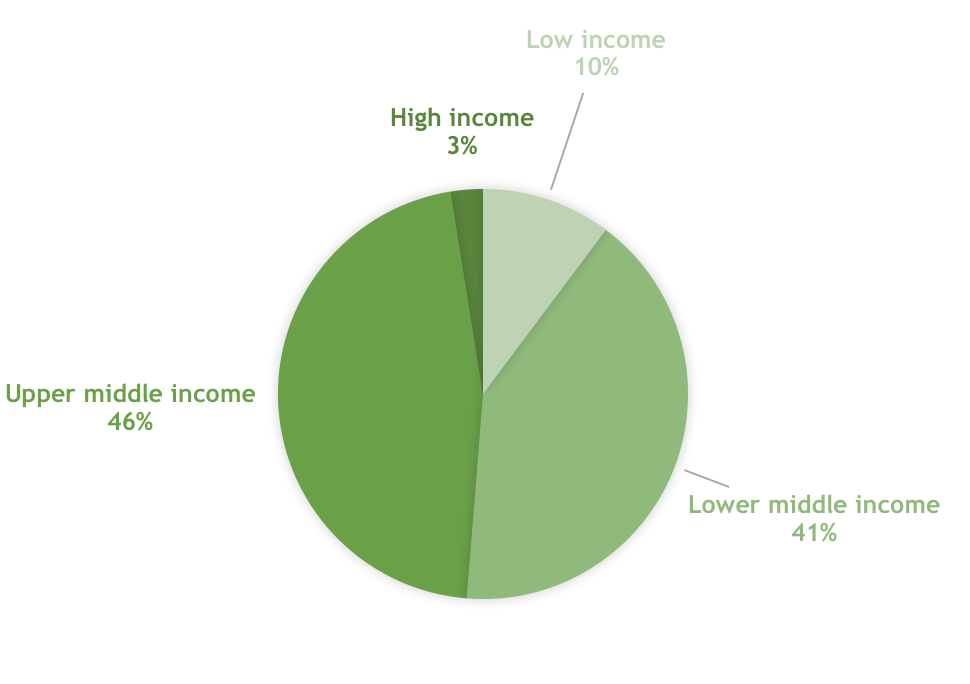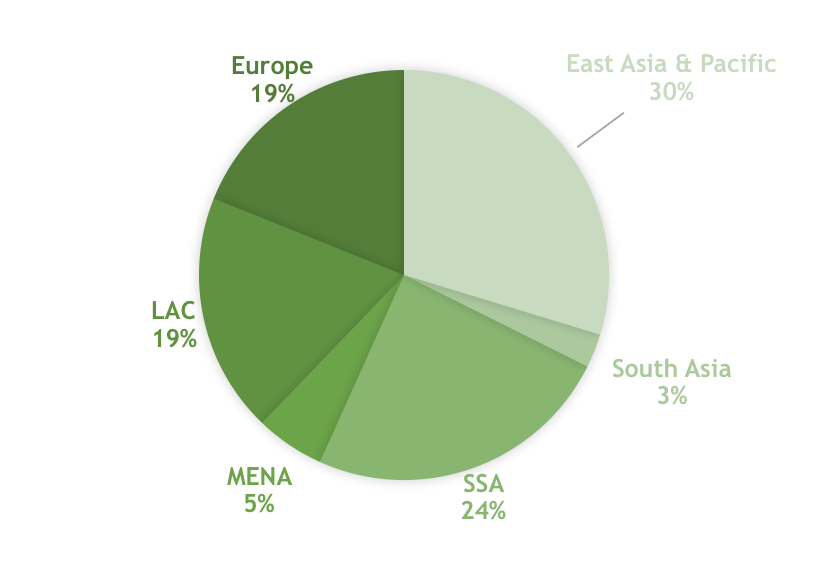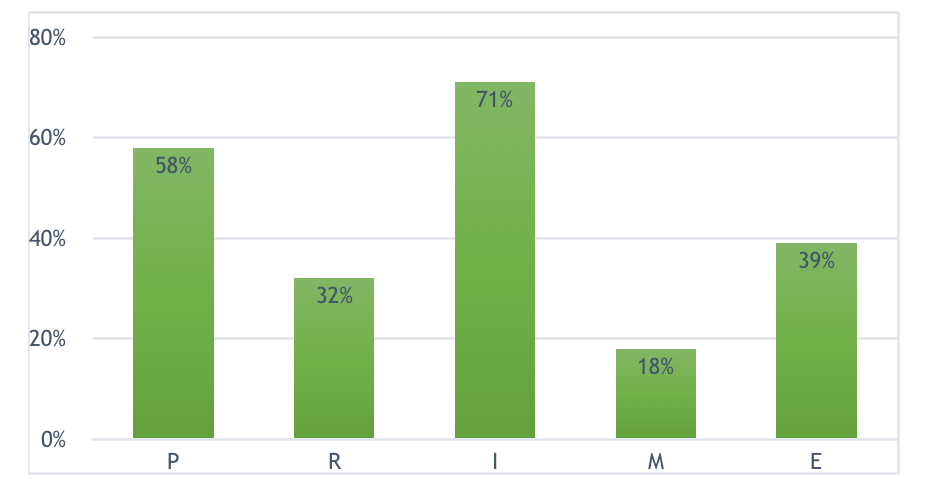World Bank Portfolio Review
The portfolio review assessed how World Bank Group forestry or forestry-related projects align with PRIME using the WBG’s Forest Strategy in 2002 to evaluate under one forest policy framework.
- World Bank Forest Project Database This review was undertaken on investment projects larger than 0.5 million dollars in the forestry sector. Starting from 309 projects, 38 projects were analyzed.
- Methodology The review has a list of inclusion and exclusion criteria (table) linked to the PRIME framework to classify interventions achieved by the projects.
- Results The review reports that on average projects work on 2.2 PRIME pathways through their interventions. Complementary investments (I) was the most frequent type of intervention, while access to markets (M) was the least frequent.
World Bank Forest Project Database
During the period 2002-2015, the WBG had forestry investments in 309 projects. Out of these, some 88 had finished a full project cycle, i.e. they were approved, fully implemented and brought to closure.
The portfolio review focused on a subset of these completed projects (38 projects). A project was included in the analysis if: a) it was approved in 2002 or later; b) it was completed and a results assessment was publicly available; c) at least 20 percent of the project was focused on the forestry sector, ensuring the project’s relevance for the sector; and d) WBG funding for the forestry-related components amounted to at least US$ 0.5 million, i.e. was large enough to include multiple action items. Thirty-eight projects met these criteria. Across the sample of 38 projects assessed, the average amount of WBG funding for each project was US$ 33.45 million, in grants and loans. The largest amount of funding for any single project was a credit of US$ 108 million to India.
Data for the review comes from a database created in 2015-16 for the World Bank’s latest Forest Action Plan. This dataset was supplemented with a detailed review of publicly available project documents prepared at the beginning and end of each project: the Project Appraisal Document (PAD, see example here), and Implementation Completion Report (ICR, see example here).
PRIME Criteria for analysis
To determine whether and where project components aligned with PRIME, the decision criteria listed in Table 1
were applied. For example, for an intervention to be counted under “R”, rights had to be strengthened either
informally or formally through a law or regulation. Under “I”, projects counted only if the regional
complementary investment was supporting people’s livelihoods in forest landscapes, for example through
investments in improved telecommunication services to access markets, by improving access roads or through
lowering the regulatory burden for small-scale forest enterprises. For “E” interventions were only included if
the returns for ecosystem services supported livelihoods, i.e. by creating additional jobs or commercial
opportunities, but not if they had a conservation focus.
| Theme | Inclusion Criteria & Examples | Exclusion Criteria |
|---|---|---|
| Productivity |
Include if intervention boosts productivity through enhancements to forestry land, machinery or labor. Examples: Training individuals or communities in forest management (e.g. planting, harvesting, monitoring), management of non-timber forest products and/or agroforestry production Providing machinery and/or technology to enhance productivity, such as portable saw mills, seedlings, or fertilizer |
Exclude if intervention focuses on enhancing agricultural or other non-forest sector productivity. |
| Rights |
Include if the intervention strengthens formal or informal rights (including decision-making processes) over forests/land. Examples: Granting individuals and/or communities forest and tree ownership and/or use rights Strengthening inclusive forest user groups |
Exclude if the intervention only includes participatory component in project design, implementation and/or monitoring. |
| Regional complementary Investments |
Include if the intervention provides complementary investments in institutions, infrastructure and public services at the regional level that support the forestry sector. Examples: Improving the functioning of forestry institutions, such as reducing bureaucratic/legal hindrances and streamlining of regulatory processes for small-scale forest enterprises or creating institutional mechanisms to enhance forest economic activities Introducing safety net programs tied to remote forest landscapes Improving rural connectivity, including transport and IT infrastructure to enhance forest livelihoods Increasing access to credit to support forest management, agroforestry or the production of NTFPs Increasing capacity of forest agency staff |
Exclude if the intervention supports broad-based institutional reform, such as the development of a national forest sector strategy or land use plan. |
| Market Access |
Include if the intervention enhances market access through marketing and logistics support or value addition. Examples: Introducing certification schemes for timber or origin products for NTFPs Formalizing markets for sustainable charcoal and fuelwood production Developing new/additional forest products and/or adding value to existing products Creation of producer networks and cooperatives |
Exclude if the intervention improves infrastructure access to markets, such as through roads, as this is included in "I". |
Ecosystem services |
Include if the intervention enhances the returns from ecosystem services in an equitable manner, including monetary, such as REDD or other carbon sequestration payments, as well as non-monetary income from ecosystem asset or services. Examples: Introducing payment for ecosystem services, such as REDD+ Developing nature tourism initiatives that benefit local poor Training on managing forest ecosystem services |
Exclude if the intervention is not livelihoods-oriented, i.e. if it has a conservation focus. |
Results
The average project included in the portfolio review featured 2.2 PRIME themes, supporting the notion that PRIME themes are complementary, especially institutional strengthening under the “I” component. Another key finding is that interventions that directly support commercial logging are less frequent.
Split by
Color by
The distribution of projects by the recipient country’s level of development was highly concentrated, with nearly 90%, among "lower middle" and "upper middle" income countries, under the WBG’s income status criteria (see Figure 1). Low income countries account for barely 1 in 10 projects.


